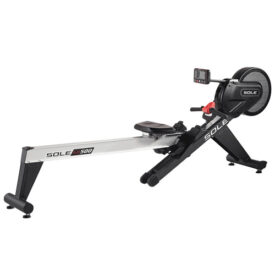
Rowing can effectively replace most of your gym routine, engaging 86% of your body's muscles through its four-phase movement cycle (rowing machine for weight loss). You'll activate major muscle groups while combining strength training and cardio in efficient 20-30 minute sessions. While rowing excels at posterior chain development and cardiovascular conditioning, you may need supplementary exercises for chest development and vertical pulling movements. Understanding proper form and programming will help you maximize rowing's full-body benefits

quick home workouts with a rower
While many exercise machines target specific muscle groups, rowing engages approximately 86% of your body's muscles through a coordinated full-body movement pattern. During each stroke, you'll activate your quadriceps, hamstrings, glutes, core, lats, shoulders, biceps, and forearms in a synchronized sequence.
The rowing motion's biomechanical efficiency stems from its four-phase cycle: catch, drive, finish, and recovery. You'll maximize energy expenditure as you shift between these phases, burning calories while building both strength and endurance. Your legs generate about 60% of the power, your core contributes 20%, and your arms deliver the remaining 20%. This distribution guarantees you're working multiple muscle groups simultaneously without overstraining any single area, making rowing one of the most time-efficient full-body workouts available.
Your rowing workout engages over 85% of your body's muscles simultaneously, while traditional weight training typically isolates muscle groups in sequence, requiring multiple exercises to achieve comparable full-body activation. You'll experience both strength-building resistance and intense cardiovascular conditioning in a single rowing session, matching or exceeding the benefits you'd get from separate weightlifting and cardio workouts. A rowing machine's compact footprint and all-in-one functionality lets you convert a small space into a complete gym, eliminating the need for multiple pieces of equipment or extensive workout areas.
Both rowing and traditional weight training offer distinct approaches to muscle activation, though they differ markedly in their mechanisms of engagement. When you're rowing, you'll activate multiple muscle groups simultaneously through fluid, compound movements that mimic natural body mechanics. This continuous muscle engagement promotes functional strength and cardiovascular endurance simultaneously.
In contrast, weight training typically isolates specific muscle groups, allowing you to target and overload individual areas with precise resistance. While this approach excels at building raw strength, it doesn't automatically provide the same full-body coordination that rowing delivers. You'll need to carefully plan your strength training routine to achieve extensive muscle development. For best results, consider how each method serves your fitness goals - rowing for integrated muscle activation and endurance, weights for targeted strength development.
Moving from muscle engagement patterns to cardiovascular demands, rowing and traditional gym workouts present distinct cardio profiles (weight loss with rowing machine). When you row properly, you'll achieve high-intensity cardio benefits comparable to running or cycling, but with lower joint impact. A 30-minute rowing session can burn between 200-300 calories, matching or exceeding many traditional gym cardio options